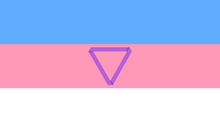Non-monogamy
Non-monogamy (or nonmonogamy) is an umbrella term for every practice or philosophy of non-dyadic intimate relationship that does not strictly hew to the standards of monogamy, particularly that of having only one person with whom to exchange sex, love, and/or affection. In that sense, "nonmonogamy" may be accurately applied to extramarital sex, group marriage, or polyamory. It is not synonymous with infidelity, since all parties are consenting to the relationship structure, partners are often committed to each other as well as to their other partners and cheating is still considered problematic behavior with many non-monogamous relationships.
| Part of a series on |
| Non-monogamy and Polyamory |
|---|
 Love outside the box |
|
Relationships |
|
Sexual practices |
|
Related topics |
More specifically, "nonmonogamy" indicates forms of interpersonal relationship, intentionally undertaken, in which demands for exclusivity (of sexual interaction or emotional connection, for example) are attenuated or eliminated, and individuals may form multiple and simultaneous sexual and/or romantic bonds.[1] This stands in contrast to monogamy, yet may arise from the same psychology.[2]
Terminology
Many terms for non-monogamous practices are vague, being based on criteria such as "relationship" or "love" that are themselves subjectively defined. There are forms of non-monogamy whose practitioners set themselves apart by qualifiers, such as "ethically non-monogamous" which intends a distancing from the deceit or subterfuge they perceive in common cheating and adultery. This usage creates distinctions beyond the definitions of the words. For example, though some relations might literally be both polygamous and polyamorous, polygamy usually signifies a codified form of multiple marriage, based on established religious teachings such as Plural marriage, a form of polygyny associated with the Latter Day Saint movement in the 19th-century and with present-day splinter groups from that faith, as well as evangelical sects that advocate Christian Plural Marriage.
Polyamory is based on the preferences of the participants rather than social custom or established precedent. There is no one 'right' way to engage in non-monogamy (although there are widely agreed on 'wrong' ways). Because of this, the terms for the various kinds of relationships can be vague and sometimes interchangeable. but there are some distinctions that are worth defining. For example, swingers may intentionally avoid emotional and social connection to those—other than their primary partner—with whom they have sex, so may or may not be polyamorous but are non-monogamous.
Useful Terms:
- Metamour or Meta—the common term for a person with whom a partner is shared.
- V-Structure—one person is equally involved with two partners.[3]
- Triads / Quads—three or four participants make up the primary partnership.[4]
Forms of non-monogamy are many, a few being:
- Casual relationship— Sometimes called Friends with benefits, A primarily physical relationship between two people with low expectations of commitment or emotional labor.
- Group sex and orgies---sexual activities involving more than two participants at the same time.
- Threesome—a primarily sexual arrangement involving three people.
- Open relationship (incl. open marriage)—one or both members of a committed (or married) couple have the express freedom to become sexually active with others.
- Polyamory—participants have multiple romantic partners
- Group marriage—several people form a single familial unit, with each considered to be married to all other members.
- Line families—a form of group marriage intended to outlive its original members by ongoing addition of new spouses
- Poly families—similar to group marriage, but some members may not consider themselves married to all other members.
- Hierarchical Polyamory---there is a primary romantic relationship with all other relationships being secondary to it. This structure is losing popularity as problems with couples' privilege arise.
- Kitchen Table Polyamory---Metamours are expected to know one another and be comfortable in each others' company.[5]
- Parallel Polyamory---Relationships between metas are kept separately. All may be aware of each other, but are not expected to be friends.[6]
- Group marriage—several people form a single familial unit, with each considered to be married to all other members.
- Polyfidelity—participants have multiple partners but restrict sexual activity to within a certain group.
- Primary/secondary—there is a main romantic relationship with all other relationships being second to it.[4]
- Polygamy—one person in a relationship has married multiple partners
- Relationship anarchy—participants are not bound by set rules other than whatever is explicitly agreed upon by the people involved. Romantic relationships are not given more weight than platonic ones and metas have no power over each others' relationships.
- Swinging—similar to open relationships, but conducted as an organized social activity, often involving some form of group sex. Some times simply trading partners with other swingers.
Public Health and Morality
The concepts of monogamy and marriage have been strongly intertwined for centuries, and in English-language dictionaries one is often used to define the other, as when "monogamy" is "being married to one person at a time." A common antonym is polygamy, meaning to have more than one spouse at one time.[7] As a result, monogamy is deeply entrenched within many religions, and in social regulations and law, and exceptions are condemned as incursions on both morality and public health.
To some, the term non-monogamy semantically implies that monogamy is the norm, with other forms of relational intimacy being deviant and therefore somehow unhealthy or immoral.[8] This concern over sexually transmitted diseases is despite the common practice of regular testing and sharing of recent test results prior to engaging in sexual activity.
It is often assumed that people who participate in non-monogamous sexual relationships have a higher rate of STIs. Despite reporting a higher number of sexual partners, research suggests that the risk of transmitting STIs is no higher than they are among the monogamous population.[9] This is because the non-monogamous community is more likely to be regularly tested and more open about their results. The stigma of receiving a positive result is diminished, resulting in better treatment options and fewer people who are unwittingly transmitting the disease because they were not told by the person who gave it to them.
Symbology[10]









Relationships (Outline) |
|---|
|
Endings |
The most commonly used symbol is the heart and infinty. It has been altered to reflect personalities and tastes of those who have adopted the symbol for their own. Several versions of the infinity-heart are now used to signify non-monogamy.
Because relationship anarchy (RA) is a relationship philosophy which draws its tenets from political anarchy, the main one being that all relationships (romantic and otherwise) shouldn’t be bound by any rules not agreed upon by the involved parties, the symbol for RA is the anarchist A in a heart.
The poly pride flag is, possibly, the first symbol created for the poly community and was created by Jim Evans and released into the public domain. The color blue represents the openness and honesty that is so prized among the poly community. Red is the color of love and passion, which is what drives so many people into polyamory in the first place. Black was chosen to represent solidarity with all others who have to hide their relationships due to social pressure. The symbol in the middle is a gold lowercase Greek letter called "pi" (π), which translates just to "p" - as in the first letter of "polyamory". The gold color represents the value that poly people place on emotional attachment to others.
The PAARC ribbon adapted the poly flag for use in the Polyamory Awareness and Acceptance Ribbon Campaign, taking a cue from all the other awareness campaigns use of folded ribbons. The intention was to create a virtual ribbon that could be placed on websites as a symbol of those who supported polyamory as a legitimate relationship choice, whether the website owner himself was polyamorous or not, in order to raise awareness.
A group of community leaders and organizers got together to coordinate awareness and organization efforts, and began calling themselves the Poly Leadership Network. One of the topics discussed was what kind of symbol to use for the group, and that led to a discussion about poly symbols in general. A brainstorming session resulted in two major symbols being created for the poly community. One of them was the "Love Outside The Box" symbol, which was intended to be more inclusive of all kinds of alternative love styles. The other was the purple mobius triangle seen below.
The Purple Mobius. This symbol uses the point-down triangle shape in solidarity with all the other alternative sexuality communities and their various triangles of different colors. It is purple as both a nod to the LGBT community with their frequent use of purple, and to the poly community, which seemed to also favor the color purple. The triangle itself is made of a Mobius Strip to reference the infinity symbol, which is one kind of Mobius Strip. This symbol was released into the public domain and is free to use. The Purple Mobius has been seen added to other images for poly discussion group logos, poly bookclubs, and even cross-over groups like poly atheists.
The Swing symbol used by the swinger community to identify each other in public.
Unlike the black of the polyamory flag above which represents those who must hide their relationships, the white of the non-monogamy flag represents the inevitable acceptance of society towards non-monogamous relationships and individuals. The light blue and pink are toned down versions of the red and blue of the first polyamory flag.
The Parrot Club Mascot was created in 1997 by Ray Dillinger for the public domain. The symbol was partly a play on the phrase "polly wanna cracker?" because of the habit of shortening "polyamory" to just "poly", and partly ironically because of the monogamous image of parrots. Many early poly discussion groups would place a stuffed parrot on the table in the restaurant or other venue, so that people attending the meeting would recognize them without drawing undue attention from the general public.
See also
- Adultery
- Family: the web series
- Group sex
- List of polyamorists
- List of polyamorous characters in fiction
- Polyday
- Romantic orientation
- Sociosexual orientation
References
- Are you open to an alternative lifestyle?
- 978-0-415-80055-6 Barker, Langdridge. 2009. Understanding Non-Monogamies. Routledge
- Mogilski, Justin K.; Reeve, Simon D.; Nicolas, Sylis C. A.; Donaldson, Sarah H.; Mitchell, Virginia E.; Welling, Lisa L. M. (2019). "Jealousy, Consent, and Compersion Within Monogamous and Consensually Non-Monogamous Romantic Relationships". Archives of Sexual Behavior. 48 (6): 1811–1828. doi:10.1007/s10508-018-1286-4. PMID 30607710.
- Erber, Ralph; Erber, Maureen (2017). Intimate Relationships: Issues, Theories, and Research. Web: Taylor & Francis Group. ISBN 9781351615075.
- "Parallel Polyamory, Kitchen Table Polyamory, and Knowing the Details or Not". Poly.Land. 2018-04-03. Retrieved 2020-05-22.
- Mahler, Jess (2016-08-04). "Kitchen Table Polyamory, Parallel Polyamory, and Etiquette". Jess Mahler. Retrieved 2020-05-22.
- Overall, Christine (March 2019). "Monogamy, Nonmonogamy, and Identity". Hypatia. 13 (4): 1–17. doi:10.1111/j.1527-2001.1998.tb01382.x. JSTOR 3810500.
- Frank, Katherine (January 2019). "Rethinking Risk, Culture, and Intervention in Collective Sex Environments". Archives of Sexual Behavior. 48 (1): 3–30. doi:10.1007/s10508-018-1153-3. PMID 29748787.
- Jj, Lehmiller (October 2015). "A Comparison of Sexual Health History and Practices Among Monogamous and Consensually Nonmonogamous Sexual Partners". The journal of sexual medicine. PMID 26395880. Retrieved 2020-05-22.
- "The Inn Between - Polyamory". www.theinnbetween.net. Retrieved 2020-05-22.